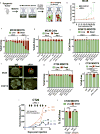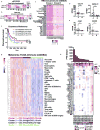Ex Vivo Profiling of PD-1 Blockade Using Organotypic Tumor Spheroids
- PMID: 29101162
- PMCID: PMC5809290
- DOI: 10.1158/2159-8290.CD-17-0833
Ex Vivo Profiling of PD-1 Blockade Using Organotypic Tumor Spheroids
Abstract
Ex vivo systems that incorporate features of the tumor microenvironment and model the dynamic response to immune checkpoint blockade (ICB) may facilitate efforts in precision immuno-oncology and the development of effective combination therapies. Here, we demonstrate the ability to interrogate ex vivo response to ICB using murine- and patient-derived organotypic tumor spheroids (MDOTS/PDOTS). MDOTS/PDOTS isolated from mouse and human tumors retain autologous lymphoid and myeloid cell populations and respond to ICB in short-term three-dimensional microfluidic culture. Response and resistance to ICB was recapitulated using MDOTS derived from established immunocompetent mouse tumor models. MDOTS profiling demonstrated that TBK1/IKKε inhibition enhanced response to PD-1 blockade, which effectively predicted tumor response in vivo Systematic profiling of secreted cytokines in PDOTS captured key features associated with response and resistance to PD-1 blockade. Thus, MDOTS/PDOTS profiling represents a novel platform to evaluate ICB using established murine models as well as clinically relevant patient specimens.Significance: Resistance to PD-1 blockade remains a challenge for many patients, and biomarkers to guide treatment are lacking. Here, we demonstrate feasibility of ex vivo profiling of PD-1 blockade to interrogate the tumor immune microenvironment, develop therapeutic combinations, and facilitate precision immuno-oncology efforts. Cancer Discov; 8(2); 196-215. ©2017 AACR.See related commentary by Balko and Sosman, p. 143See related article by Deng et al., p. 216This article is highlighted in the In This Issue feature, p. 127.
©2017 American Association for Cancer Research.
Conflict of interest statement
The authors declare no competing interests.
Figures







Comment in
-
A Critical Need for Better Cancer Immunotherapy Models: Are Organotypic Tumor Spheroid Cultures the Answer?Cancer Discov. 2018 Feb;8(2):143-145. doi: 10.1158/2159-8290.CD-17-1356. Cancer Discov. 2018. PMID: 29431673
-
TBK1 as a regulator of autoimmunity and antitumor immunity.Cell Mol Immunol. 2018 Aug;15(8):743-745. doi: 10.1038/cmi.2017.165. Epub 2018 Mar 5. Cell Mol Immunol. 2018. PMID: 29503440 Free PMC article. No abstract available.
References
-
- Ribas A, Hamid O, Daud A, Hodi FS, Wolchok JD, Kefford R, et al. Association of Pembrolizumab With Tumor Response and Survival Among Patients With Advanced Melanoma. JAMA. 2016;315:1600–9. - PubMed
Publication types
MeSH terms
Substances
Grants and funding
- R01 CA149738/CA/NCI NIH HHS/United States
- P01 CA025874/CA/NCI NIH HHS/United States
- R01 CA122794/CA/NCI NIH HHS/United States
- P30 CA010815/CA/NCI NIH HHS/United States
- T32 CA009172/CA/NCI NIH HHS/United States
- R01 CA163896/CA/NCI NIH HHS/United States
- R01 CA166480/CA/NCI NIH HHS/United States
- P50 CA174523/CA/NCI NIH HHS/United States
- R01 CA140594/CA/NCI NIH HHS/United States
- T32 GM008313/GM/NIGMS NIH HHS/United States
- R01 CA190394/CA/NCI NIH HHS/United States
- P01 CA120964/CA/NCI NIH HHS/United States
- P01 CA114046/CA/NCI NIH HHS/United States
- R01 CA047159/CA/NCI NIH HHS/United States
- U01 CA214381/CA/NCI NIH HHS/United States
LinkOut - more resources
Full Text Sources
Other Literature Sources
Medical
Miscellaneous

